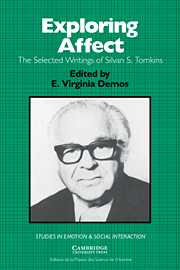Book contents
- Frontmatter
- Contents
- Foreword
- Editor's preface
- List of contributors
- Chronology
- Introduction
- Part I Affect theory
- Introduction
- Selections by Silvan S. Tomkins
- The quest for primary motives: Biography and autobiography of an idea
- Evolution of the affect system
- Role of the specific affects
- Modifications in the theory – 1978
- Part II Affect and ideology
- Introduction
- Selections by Silvan S. Tomkins
- Part III The face of affect
- Introduction
- Selections by Silvan S. Tomkins
- Part IV Script theory: The differential magnification of affect
- Introduction
- Selections by Silvan S. Tomkins
- Part V Human being theory: A foundation for the study of personality
- Introduction
- Selections by Silvan S. Tomkins
- A complete annotated bibliography of Silvan S. Tomkins's writings
- References
- Author index
- Subject index
- Titles in the series
Role of the specific affects
Published online by Cambridge University Press: 10 November 2010
- Frontmatter
- Contents
- Foreword
- Editor's preface
- List of contributors
- Chronology
- Introduction
- Part I Affect theory
- Introduction
- Selections by Silvan S. Tomkins
- The quest for primary motives: Biography and autobiography of an idea
- Evolution of the affect system
- Role of the specific affects
- Modifications in the theory – 1978
- Part II Affect and ideology
- Introduction
- Selections by Silvan S. Tomkins
- Part III The face of affect
- Introduction
- Selections by Silvan S. Tomkins
- Part IV Script theory: The differential magnification of affect
- Introduction
- Selections by Silvan S. Tomkins
- Part V Human being theory: A foundation for the study of personality
- Introduction
- Selections by Silvan S. Tomkins
- A complete annotated bibliography of Silvan S. Tomkins's writings
- References
- Author index
- Subject index
- Titles in the series
Summary
Let us consider now some of the consequences of the affect theory for each of the specific primary affects. We shall begin with startle, fear, and interest, which differ, with respect to activation, only in the rate at which stimulation or neural firing increases.
Startle
Startle appears to be activated by a critical rate of increase in the density of neural firing. The difference between startle (or surprise in its weaker form) and interest is a difference in the steepness of the gradient of stimulation. The same stimulus, therefore, may evoke surprise or interest, depending on the steepness of the rise of stimulation (which in turn depends on numerous factors, prominent among which is the degree of unexpectedness). Thus, a gun shot will evoke startle rather than interest. An unexpected tap on the shoulder by someone who is not seen will also evoke startle rather than interest. In the case of the gun shot, the suddenness of increase of stimulation was primarily in the auditory stimulus itself. In the tap on the shoulder the suddenness of this stimulus might have been sufficient, but the overall density of stimulation was so low as to have been insufficient to become conscious in the competition between messages for transformation into reports. We assume that such a weak stimulus must recruit information from memory, which has a steep rate of increase of neural firing to activate a sequence of further, more rapid retrievals which summate to activate startle.
- Type
- Chapter
- Information
- Exploring AffectThe Selected Writings of Silvan S Tomkins, pp. 68 - 85Publisher: Cambridge University PressPrint publication year: 1995
- 1
- Cited by



